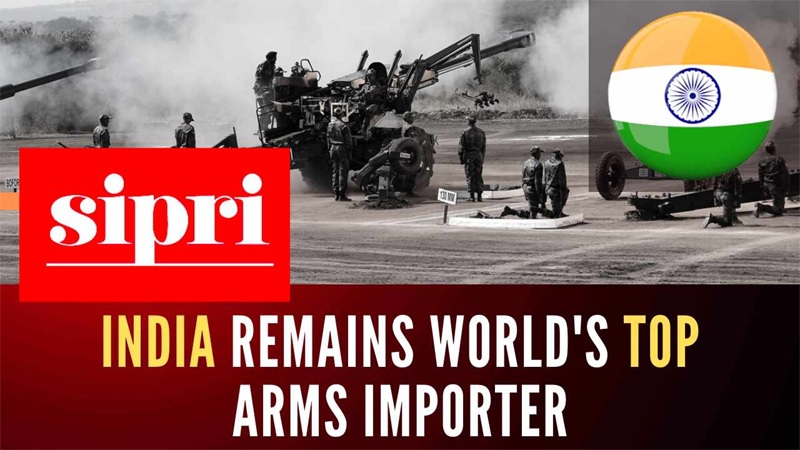Context:
According to a report by SIPRI, India was ranked as the world’s top arms importer for the period 2019-23.
Key Highlights of the Report
- India was the world’s top arms importer for the period 2019-23 with imports having gone up by 4.7% compared to the period 2014-18.
- Arms imports by European countries surged by 94% between 2014–18 and 2019–23, possibly influenced by the war in Ukraine.
- Russia remained India’s primary arms supplier, accounting for 36% of its arms imports. However, this period marked the first time since 1960–64 when deliveries from Russia comprised less than half of India’s arms imports.
- Nine out of the top 10 biggest arms importers in 2019–23 were located in Asia and Oceania or the Middle East, including India, Saudi Arabia, and Qatar among the top three.
- Ukraine emerged as the fourth largest arms importer globally during the period, receiving transfers of major arms from over 30 states in 2022-23.
The Stockholm International Peace Research Institute (SIPRI)
SIPRI is an independent international institute dedicated to research on issues related to conflict, armaments, arms control, and disarmament.
Mission and Focus:
- Established in 1966, SIPRI provides data, analysis, and recommendations based on open sources.
- SIPRI’s publications, such as the SIPRI Yearbook, are highly respected resources for policymakers and scholars globally.
Core areas include:
- Armed conflict
- Military expenditure and arms trade
- Disarmament and arms control
Headquarters and Funding:
- SIPRI is located in Stockholm, Sweden.
- It receives funding from the Swedish government and various other
Top Arm Importers
- India is the top importer of arms followed by Saudi Arabia (8.4%), Qatar (7.6%), Ukraine (4.9%), Pakistan (4.3%), Japan (4.1%), Egypt (4%), Australia (3.7%), South Korea (3.1%) and China (2.9%).

Top Arm Exporters
- The top 10 arms exporters are US (42%), France (11%), Russia (11%), China (5.8%), Germany (5.6%), Italy (4.3%), UK (3.7%), Spain (2.7%), Israel (2.4%) and South Korea (2%).

Reasons for high Import dependency
Geopolitical Tensions:
- Border Disputes: Long-standing territorial disputes with neighbouring countries, particularly China and Pakistan, necessitate a strong military presence along the borders.
- Perceived Security Threats: The volatile regional security situation with ongoing border skirmishes and concerns over cross-border terrorism fuel the need for advanced weaponry.
Military Modernization:
- Aging Inventory: A significant portion of the Indian armed forces’ equipment is outdated and requires urgent modernization to effectively counter contemporary threats.
- Indigenization Efforts: While India strives to achieve self-reliance in defence equipment, the indigenous industry is still developing, leading to a gap that imports bridge.
Technological Advancements:
- Rapid Evolution: The constant evolution of warfare necessitates acquiring advanced weaponry like fighter jets, missile defence systems, and other sophisticated equipment.
- Limited Domestic Capabilities: India still lags in certain high-end defence technologies, necessitating imports to maintain a technologically sound military.
Impacts of High Arms Import
Economic Burden: Large expenditures on imported arms strain the national budget, potentially diverting resources from crucial areas like infrastructure and social development.
- India spent over US $10.5 billion in arms imports during the last three years and is expected to spend another $30 billion in the next five years.
Dependence on Foreign Suppliers: Geopolitical situations can influence the reliability of foreign suppliers, impacting access to crucial weaponry.
- Strained relations with traditional suppliers like Russia due to the Ukraine war highlight the vulnerability associated with dependence on external sources.
- Limited Leverage: Over-reliance on external sources weakens India’s bargaining power in negotiating arms deals and technology transfer agreements.
- Impact on Domestic Industry: Excessive reliance on imports can stifle the growth of the indigenous defence sector, hindering long-term self-sufficiency goals.
Addressing the Issue
Boosting Indigenous Arms Industry: The government’s “Make in India” initiative aims to promote domestic production of defence equipment, gradually reducing reliance on imports.
- An increase in defence exports from ₹16,000 crores to a projected ₹40,000 crore in two years indicates potential for a more robust domestic defence industry and a significant positive step towards reducing import reliance.
Increased R&D Spending: Investing in research and development to bridge the technological gap and achieve self-sufficiency in critical defence sectors.
Strategic Partnerships: Collaborating with foreign countries for technology transfer and joint ventures to expedite indigenous production capabilities.

